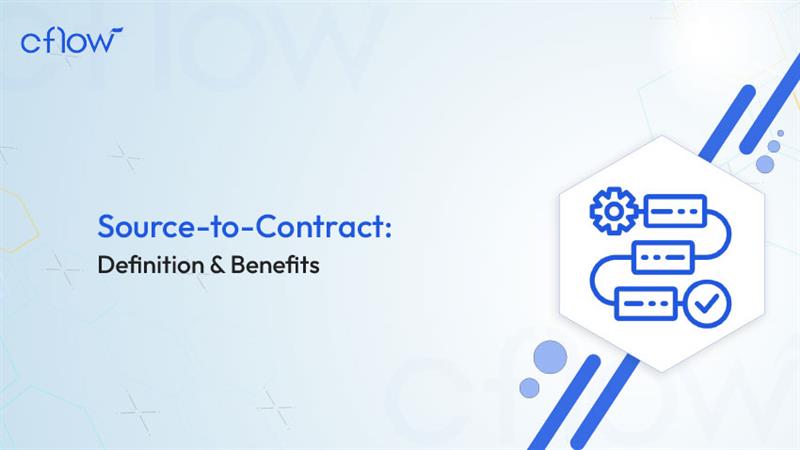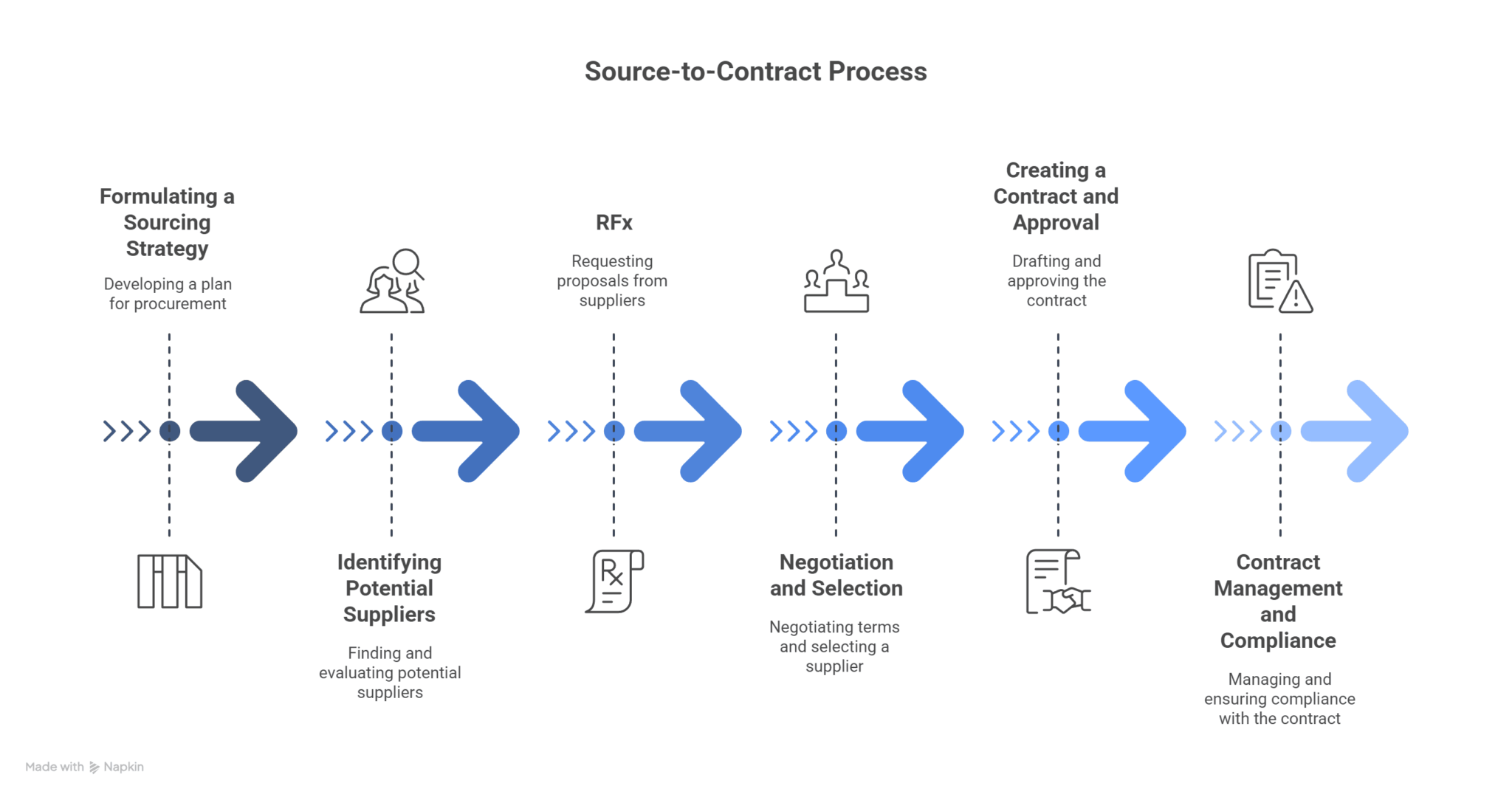Source-to-Contract: The Key to Streamlining Your Business

Key takeaways
Manual procurement processes cause delays, errors, and missed savings—modernisation is critical to stay competitive.
The Source-to-Contract (S2C) process covers sourcing, supplier selection, negotiation, and contract approval, forming the backbone of strategic procurement.
S2C differs from Procure-to-Pay (P2P) by focusing on pre-procurement activities like supplier evaluation and contract management, while P2P handles transactional workflows.
S2C improves cost optimisation, enhances supplier relationships, ensures compliance, and enables data-driven procurement decisions.
Tools like Cflow simplify sourcing, automate RFx processes, manage contracts digitally, and provide real-time insights through a centralised, cloud-based platform.
Procurement will become a big headache if you don’t modernise your outdated processes. When it comes to procurement, manual, time-consuming processes are a big hurdle to gaining a competitive advantage. In addition, it affects productivity, accuracy, and financial gains and hinders successful outcomes.
Procurement and accounts payable processes are the heart of any business and are crucial points of transformation. The procurement team is responsible for managing the flow of resources, forecasting costs, analysing risks, and negotiating the best prices with the best suppliers.
From sourcing to contracting to procuring to paying – it’s a complex cycle altogether, which is prone to inefficiencies. This blog highlights the source-to-contract process, the difference between source-to-contract vs. procure-to-pay, the need for strengthening them, and how Cflow can be your best choice for procurement.
Table of Contents
Source-to-Contract Defined
Sourcing is the process of identifying, evaluating, and selecting the most suitable suppliers for procuring goods and services. Sourcing should be applied strategically to get maximum cost benefit. On the other hand, the contract process includes creation, negotiation, conditions, compliance, and approval phases between a vendor and a supplier.
The source-to-contract (S2C) is defined as the procurement process that a company undertakes, which includes formulating sourcing strategies, getting quotes, contract negotiations, and approving and rewarding suppliers with the contracts. It plays an important role in delivering the final goods and services. The source-to-contract phase pretty much includes the entire procurement cycle in a business.
How Does It Work – Source-to-Contract?
As accounting professionals, you don’t need to have extensive knowledge of procurement, but knowing the fundamentals is always helpful. The source-to-contract typically includes the following stages:

- Formulating a sourcing strategy
- Identifying potential suppliers and evaluating
- RFx
- Negotiation and selection
- Creating a contract and approval
- Contract management and compliance
Some of these stages may vary depending on the organisation’s procurement needs, but these are the key stages that make up a complete source-to-contract process.
Before you start making the sourcing strategy, you need to do a “spend analysis.” Here you will be using a source-to-contract software like Cflow, which enables you to identify maverick spending and get better visibility over finances. Also, you can improve overall compliance regulations and manage contracts effectively.
1. Formulating a sourcing strategy
You will understand your organisation’s sourcing needs, goals, and strategies. Then, a strategy is developed based on whether to source the goods and services externally or internally. A thorough evaluation of the organisation’s needs is necessary.
2. Identifying potential suppliers and evaluation
Suppliers are identified and selected based on certain criteria such as capacity, cost, quality, capability, and compliance. With this evaluation, you can easily identify the list of suppliers who meet the procurement needs and evaluate them accordingly.
3. RFx
RFx can include anything – request for proposal (RFP), request for information (RFI), request for quotation (RFQ), request for information (RFI). It encompasses the formal request process.
After identifying and evaluating the potential suppliers, you will need comprehensive information regarding the goods, services, cost, quality, and delivery of the intended products based on the firm’s needs. Your organisation will come up with an RFI including all the necessary information for a negotiation and contract.
Following the RFI, the selected suppliers will receive an RFP or RFQ which encompasses the detailed specifications of products, terms and conditions of purchase, and other compliance regulations. Interested suppliers or vendors will reply with quotes or proposals.
4. Negotiation and selection
After receiving the proposals from suppliers now the organisation will get ready for negotiation. They will meet with the suppliers and negotiate purchase costs, altering terms and conditions, prices, and other terms in the contract. The suppliers will be selected based on the best value that they can deliver to your firm, and that both parties are equally satisfied.
Discover why teams choose Cflow
5. Creating a contract and approval
Now the terms and conditions discussed with the selected suppliers will be put into words in the form of a formal contract. The contract should include all the procurement terms and conditions, deliverables, cost, quantity and quality, ownership of intellectual property, and other procurement aspects.
Upon delivering the formal contract, it is sent for approval to the relevant stakeholders, the legal procurement team, and the management team. The contract goes through several stages of review before the final approval. Once all the conditions are met and reviewed, the contract is approved.
6. Contract management and compliance
Once the contract is approved and signed, it should be managed properly to establish a long-lasting relationship with the suppliers. You need to monitor their performance and ensure that the contract conditions are always followed. You can use KPIs and resolve any issues that could occur in a timely manner.
Now that you have seen the different stages, let’s see how it actually works. It involves three steps:
- Supplier sourcing
- Conducting a competitive tender
- Contract allocation
7. Supplier sourcing
This step involves strategic sourcing, where you will come up with a list of eligible suppliers who can fulfil all the requirements of your organisation. This is done by a procurement expert who will compile data and formulate a budget, lead times, and order quantities during the sourcing stage. The procurement expert spends time vetting the best suppliers who can provide the best quality products and services needed. When sourcing is done economically, it adds value to the procurement process and enhances business efficiency.
8. Conducting a competitive tender
This is the tendering phase, where a bidding process is conducted. This event can be used when you need a list of potential products and services offered by the selected suppliers. Here, RFP and RFQ are sent and received.
9. Contract allocation
The contract is awarded to the supplier whose proposal meets your procurement requirements. To complete a purchase, a purchase order is created that includes all the terms and conditions. Then it moves to the approval workflow and documentation of the contact agreement.
When the contract is approved and documented, the source-to-contract process is finally completed.
End-to-end workflow automation
Build fully-customizable, no code process workflows in a jiffy.
Source-to-Contract vs Procure-to-Pay
In the realm of procurement, both S2C and P2P are used simultaneously and are distinctively related to each other, yet so different.
| Source-to-Contract (S2C) | Procure-to-Pay (P2P) |
| This mainly includes the pre-procurement stages such as strategic sourcing, selecting the suppliers, negotiation, contracting, and management. | On the other hand, P2P encompasses the complete procurement cycle from payment to supplier relationship management. |
| The main goal of S2C is to find the best supplier, negotiate the best terms and conditions, and establish a contract that meets your firm’s needs by optimising costs and benefits for both sides. | P2P focuses mainly on the automation aspects. It helps streamline and automate the procurement process, ensuring that every aspect of procurement falls under the compliance regulation, manages supplier transactions, and controls spending efficiently. |
| The S2C process includes activities such as supplier identification and evaluation, RFx, negotiation, contract and spend analysis. | The P2P process includes activities such as order creation, invoice processing, approval, goods receipt, and vendor performance analysis. |
| The S2C process focuses on establishing relationships with potential suppliers during the sourcing and contracting phases. They ensure that the relationships align with the organisation’s goals and objectives. | The P2P process focuses on the interactions with the suppliers rather than relationship building. It focuses primarily on transactional efficiency, compliance, and accuracy, which foster collaboration and enhance the efficiency of the performance. |
| In terms of technology, S2C depends on strategic sourcing and contracting software and procurement lifecycle management tools that streamline the different activities, such as supplier discovery, RFx and sending proposals, creating contracts, etc. | The P2P process depends on procurement software and enterprise resource planning (ERP) tools to automate the purchase process workflows, use approval workflows, automated invoice processing and management, etc. |
Benefits of S2C
- Throughout the procurement lifecycle, a proper source-to-contract process can help in saving cost, optimising spending, streamlining supplier selection and negotiation, and helping procurement teams to concentrate on critical tasks.
- Enhanced supplier relationships resulting in openness, transparency, communication, and a better understanding of the customers. This helps procurement teams to come up with innovative solutions.
- The source-to-contract process enhances risk mitigation and helps incorporate it into the procurement lifecycle. They help procurement teams focus on analysing supplier efficiency, financial stability, compliance, and adherence to rules.
- Improved accountability through proper auditing and documentation of strategic sourcing tactics, which helps in decision-making.
- S2C helps in making informed decisions and deriving data-driven insights from spend analysis, market research, and supplier KPI measurement. Adopting an S2C tool like Cflow can optimise procurement activities further and improve the overall organisation’s competitiveness.
Try Cflow for free, no credit card needed
Why Cflow?
Cflow offers solid source-to-contract services that enable you to have a holistic approach to your spending, suppliers, and contracting. Cflow offers customised functionality for conducting spend analysis, sourcing, supplier management, contract management, etc.
Cflow offers advanced analytics and real-time data to monitor your spending, which helps gain deeper insights into your organisation’s procurement activities.
For sourcing, Cflow lets you streamline and vet the best suppliers with its automation. Since it is completely cloud-based, contract management becomes simple, where every piece of information is stored and accessed from a centralised location, providing maximum visibility and eliminating the need for paper-based manual documentation processes.
In addition, Cflow acts as a unified procurement platform that offers additional functionalities such as supplier risk performance, supply chain collaboration, inventory control, e-procurement, and much more.
Interested? Visit Cflow for more information and sign up for a free demo today!
Frequently Asked Questions
1. What is the Source-to-Contract (S2C) process in procurement?
The Source-to-Contract process refers to the strategic steps involved in identifying suppliers, requesting proposals (RFx), negotiating terms, and formalising supplier contracts. It covers everything from spend analysis to contract approval and ensures businesses choose the best suppliers under optimal terms.
2. How is Source-to-Contract different from Procure-to-Pay (P2P)?
S2C focuses on the pre-procurement phase—strategic sourcing, supplier evaluation, and contract creation. P2P begins after the contract is signed and deals with purchase orders, invoicing, goods receipt, and payments. Together, they complete the end-to-end procurement lifecycle.
3. Why is Source-to-Contract important for businesses?
S2C helps reduce costs, improve supplier quality, and strengthen compliance. It ensures better negotiations, optimised supplier selection, and transparent contract management, leading to long-term procurement success and strategic advantages.
4. What are the main stages of the Source-to-Contract process?
Key stages include formulating sourcing strategies, identifying and evaluating suppliers, managing RFx, negotiating terms, creating and approving contracts, and ensuring contract compliance and performance monitoring.
5. How can automation improve the Source-to-Contract process?
Automation reduces manual effort, speeds up supplier evaluation, tracks spending accurately, manages contracts digitally, and provides real-time insights. This leads to fewer errors, faster decisions, and improved procurement efficiency.
6. How does Cflow help in managing the Source-to-Contract process?
Cflow offers a no-code platform that streamlines every step of the S2C process—from spend analysis and supplier management to contract automation. It enhances visibility, improves compliance, and supports smarter sourcing through real-time analytics.
Related Article
- Automated Invoice Matching: How to Reduce Errors and Improve Vendor Payments
- The Credit Management Process: The Key to Achieving Financial Stability
- 10 Best Accounts Payable Software Tools For 2025
- Real-time Tracking and Efficient Spend Control with E‑Procurement Solutions
- Procurement vs. Purchasing – Ultimate Guide to Automate your Procurement Process
- Importance of Vendor Management Systems in Procurement
Thanks for reading till the end. Here are 3 ways we can help you automate your business: Create workflows with multiple steps, parallel reviewals. auto approvals, public forms,
etc. to save time and cost. Get a 30-min. free consultation with our Workflow expert to optimize
your daily tasks. Explore our workflow automation blogs, ebooks, and other resources to master
workflow automation.What should you do next?

Do better workflow automation with Cflow

Talk to a workflow expert

Get smarter with our workflow resources
Get Your Workflows Automated for Free!

